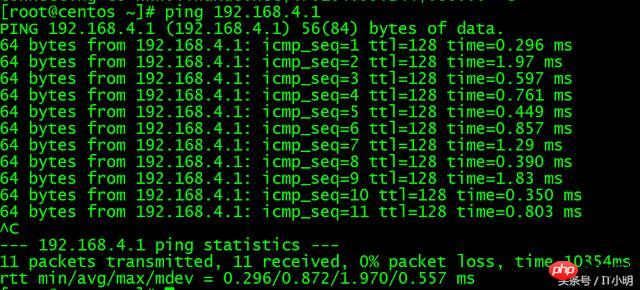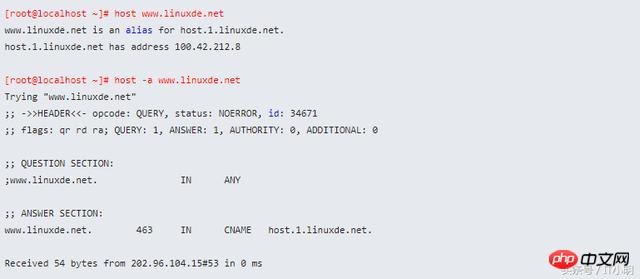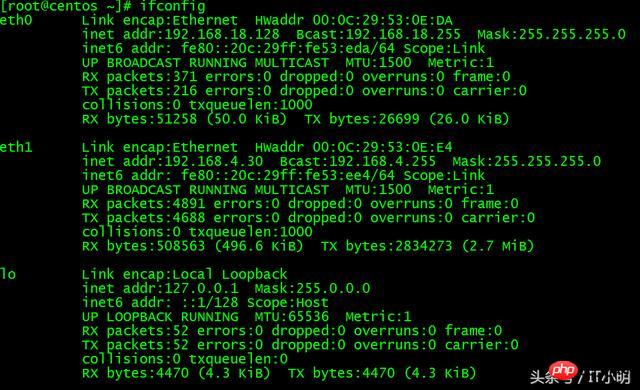Top 10 network commands under Linux
In order to better use Linux, we must know some necessary network commands of Linux and better understand the performance of Linux.
1. curl
The curl command is a file transfer tool that uses URL rules to work under the command line. It supports file upload and download, so it is a comprehensive transmission tool. However, according to tradition, curl is called a download tool. As a powerful tool, curl supports many protocols including HTTP, HTTPS, ftp, etc. It also supports features such as POST, cookies, authentication, downloading partial files from specified offsets, user agent strings, speed limits, file sizes, progress bars, etc. . To automate web page processing and data retrieval, curl can help.
The curl command can be used to perform operations such as downloading, sending various HTTP requests, and specifying HTTP headers. If the system does not have curl, you can use yum install curl to install it, or you can download and install it. curl outputs the downloaded file to stdout and outputs the progress information to stderr. Use the --silent
option to not display progress information.
curl URL --silent
2. wget
The wget command is used to download files from the specified URL. wget is very stable, and it has strong adaptability in situations with very narrow bandwidth and unstable networks. If the download fails due to network reasons, wget will continue to try until the entire file is downloaded. If the server interrupts the download process, it will contact the server again and continue downloading from where it stopped. This is useful for downloading large files from servers that have limited connection times.

3. ping
The ping command is used to test the network connectivity between hosts. Executing the ping command will use the ICMP transport protocol to send a message requesting a response. If there is no problem with the network function of the remote host, it will respond to the message, thus knowing that the host is operating normally.

4. traceroute
The traceroute command is used to trace the entire path of data packets when they are transmitted on the network. The default packet size sent is 40 byte.
Through traceroute we can know the path that information takes from your computer to the host at the other end of the Internet. Of course, the path a data packet takes from the same starting point (source) to the same destination (destination) may be different every time, but basically the route taken is the same most of the time.
traceroute measures how long it takes by sending small packets to the destination device until it returns. Each device on a path is traceroute tested three times. The output includes the time (ms) of each test and the name of the device (if any) and its IP address.

5. The host
host command is a commonly used analysis domain name query tool and can be used to test whether the domain name system is working properly.

6. Whois
is used to find and display information related to the specified user account and domain name, including domain name registration time, owner, email, etc. Similar commands : tracepath, host, nslookup, who, pwd.

7. ifplugstatus
The ifplugstatus command can tell you whether there is a network cable plugged into the network interface. This command is not pre-installed in Ubuntu. Use the following command to install it
sudo apt-get install ifplugd
This command can view the status of all network interfaces or the status of a specified network interface
8. ifconfig
The ifconfig command is used to configure and display the network parameters of the network interface in the Linux kernel. The network card information configured with the ifconfig command will no longer exist after the network card is restarted and the machine is restarted. If you want to store the above configuration information in your computer forever, you need to modify the configuration file of the network card.

9. ifdown/ifup
The ifdown command is used to disable the specified network interface. The ifup command is used to start the specified network interface;
10. netstat
The netstat command is used to print the status information of the network system in Linux, allowing you to know the network status of the entire Linux system.

Hot AI Tools

Undresser.AI Undress
AI-powered app for creating realistic nude photos

AI Clothes Remover
Online AI tool for removing clothes from photos.

Undress AI Tool
Undress images for free

Clothoff.io
AI clothes remover

Video Face Swap
Swap faces in any video effortlessly with our completely free AI face swap tool!

Hot Article

Hot Tools

Notepad++7.3.1
Easy-to-use and free code editor

SublimeText3 Chinese version
Chinese version, very easy to use

Zend Studio 13.0.1
Powerful PHP integrated development environment

Dreamweaver CS6
Visual web development tools

SublimeText3 Mac version
God-level code editing software (SublimeText3)

Hot Topics
 What computer configuration is required for vscode
Apr 15, 2025 pm 09:48 PM
What computer configuration is required for vscode
Apr 15, 2025 pm 09:48 PM
VS Code system requirements: Operating system: Windows 10 and above, macOS 10.12 and above, Linux distribution processor: minimum 1.6 GHz, recommended 2.0 GHz and above memory: minimum 512 MB, recommended 4 GB and above storage space: minimum 250 MB, recommended 1 GB and above other requirements: stable network connection, Xorg/Wayland (Linux)
 Linux Architecture: Unveiling the 5 Basic Components
Apr 20, 2025 am 12:04 AM
Linux Architecture: Unveiling the 5 Basic Components
Apr 20, 2025 am 12:04 AM
The five basic components of the Linux system are: 1. Kernel, 2. System library, 3. System utilities, 4. Graphical user interface, 5. Applications. The kernel manages hardware resources, the system library provides precompiled functions, system utilities are used for system management, the GUI provides visual interaction, and applications use these components to implement functions.
 vscode terminal usage tutorial
Apr 15, 2025 pm 10:09 PM
vscode terminal usage tutorial
Apr 15, 2025 pm 10:09 PM
vscode built-in terminal is a development tool that allows running commands and scripts within the editor to simplify the development process. How to use vscode terminal: Open the terminal with the shortcut key (Ctrl/Cmd). Enter a command or run the script. Use hotkeys (such as Ctrl L to clear the terminal). Change the working directory (such as the cd command). Advanced features include debug mode, automatic code snippet completion, and interactive command history.
 How to check the warehouse address of git
Apr 17, 2025 pm 01:54 PM
How to check the warehouse address of git
Apr 17, 2025 pm 01:54 PM
To view the Git repository address, perform the following steps: 1. Open the command line and navigate to the repository directory; 2. Run the "git remote -v" command; 3. View the repository name in the output and its corresponding address.
 Where to write code in vscode
Apr 15, 2025 pm 09:54 PM
Where to write code in vscode
Apr 15, 2025 pm 09:54 PM
Writing code in Visual Studio Code (VSCode) is simple and easy to use. Just install VSCode, create a project, select a language, create a file, write code, save and run it. The advantages of VSCode include cross-platform, free and open source, powerful features, rich extensions, and lightweight and fast.
 How to run java code in notepad
Apr 16, 2025 pm 07:39 PM
How to run java code in notepad
Apr 16, 2025 pm 07:39 PM
Although Notepad cannot run Java code directly, it can be achieved by using other tools: using the command line compiler (javac) to generate a bytecode file (filename.class). Use the Java interpreter (java) to interpret bytecode, execute the code, and output the result.
 What is the main purpose of Linux?
Apr 16, 2025 am 12:19 AM
What is the main purpose of Linux?
Apr 16, 2025 am 12:19 AM
The main uses of Linux include: 1. Server operating system, 2. Embedded system, 3. Desktop operating system, 4. Development and testing environment. Linux excels in these areas, providing stability, security and efficient development tools.
 How to run sublime after writing the code
Apr 16, 2025 am 08:51 AM
How to run sublime after writing the code
Apr 16, 2025 am 08:51 AM
There are six ways to run code in Sublime: through hotkeys, menus, build systems, command lines, set default build systems, and custom build commands, and run individual files/projects by right-clicking on projects/files. The build system availability depends on the installation of Sublime Text.






